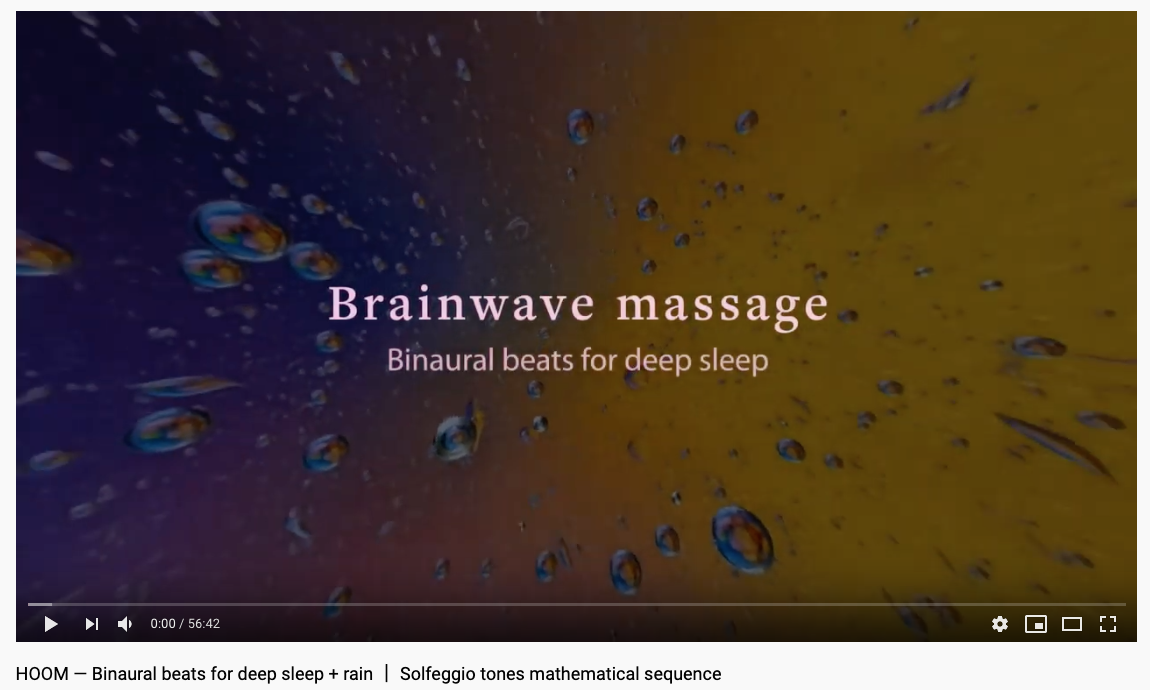Hoom secret #4: binaural frequencies
Binaural frequencies are fascinating. Not only listening to them allows you to sleep faster, but they also give you a feeling of deep well-being.
Hoom thus did not hesitate to add them, in different ways, to its sounds and stories.
Because there are as many sleeper profiles as sleepers, the HoomBand application (available for Android and Iphone) wants to be the most complete possible, to provide a customisable solution, depending on the mood or sensitivity of each.
In this article, we try to understand how the frequencies work and especially why they are so effective on sleep.
Summary:
- 1- What exactly is a binaural frequency?
- 2- Its effectiveness on the quality of your sleep
- 3- Improving sleep, but not only...
1- What exactly is a binaural frequency?
They are sounds listened to with an audio headset and whose frequency is different from one ear to the other.
Your right ear perceives frequency #1 and your left ear perceives frequency #2 at the same time, but the sound content is identical and “pleasant” to listen to.
Normally, the two halves of the brain function at different rhythms, however according to the work of Foster (in 1990), these sounds have the ability to synchronise these two halves. With surprising results...
2- Its effectiveness on the quality of your sleep
All brains emit waves, whose frequencies we measure in hertz.
There are 5:
- Gamma waves (above 38 hertz): they are related to a state of intense concentration, such as creativity or intellectual work.
- Bêta waves (between 12 and 38 hertz): this is the alert state. Our brain emits them when our attention is focused on the outside world. These are the waves we emit the most.
- Alpha waves (between 8 and 12 hertz): this is a light relaxed state.
- Thêta waves (between 3 and 8 hertz): this is a deep or hypnotic relaxation state.
- Delta waves (between 0.2 and 3 hertz): this is the very deep sleep state.
We don’t have a way to “control” the emission of our brain waves (except people who enter into a very deep meditation state).
But by listening to binaural frequencies, it can be possible!
When your right ear perceives a frequency of 400 hertz and the left ear perceives a frequency of 395 hertz, your brain will emit waves corresponding to the difference between the two frequencies, at 5 hertz (which would correspond to the emission of Theta waves and thus induces a deep relaxation state).
The lower the difference, the deeper the relaxation.
A study published in 2019 specifies the scope of binaural frequencies by showing that they can increase the positive emotions felt by listeners and the quality of sleep. [1]
3- Improving sleep, but not only...
Numerous studies looked into the effects of binaural frequencies on the human body.
And this goes far beyond sleep, since binaural frequencies would be particularly effective for:
- increasing attention [2]
- providing physical and mental relaxation [3]
- controlling the depressive state [4]
- relieving anxiety in general [5]
Binaural frequencies merit being discovered and used by many people. The deep relaxation state that they induce would fight naturally against stress and improves sleep quality.
To recap
Binaural frequencies and your HoomBand are thus especially effective:
- if you have trouble entering a deep relaxed state
- if you would like to improve your intellectual and creative capacities
- if you are going through a depressive episode or your thoughts are not very optimistic at the moment
Here is an example of binaural frequency sound, available in the HoomBand application (available for Android and Iphone):

Our library of sounds and stories is frequently updated. Every night, its atmosphere!
Discover other HoomBand secrets for you to fall asleep:
Sources
[1] Possible Effect of Binaural Beat Combined With Autonomous Sensory Meridian Response for Inducing Sleep, Minji Lee et al, FRont Hum Neurosci, 2019
[2] Binaural auditory beats affect vigilance performance and mood, Lane JD et al, Physiol Behav, 1998
[3] EEG and subjective correlates of alpha frequency binaural-beat stimulation combined with alpha biofeedback, Foster, Hemi-Sync 1990
[4] QEEG correlates of auditory-visual entrainment treatment efficacy of refractory depression, Cantor D. S., Stevens E., J. Neurother. 2009
[5] Use of binaural beat tapes for treatment of anxiety: a pilot study of tape preference and outcomes, Le Scouarnec RP et al, Altern Ther Health Med. 2001